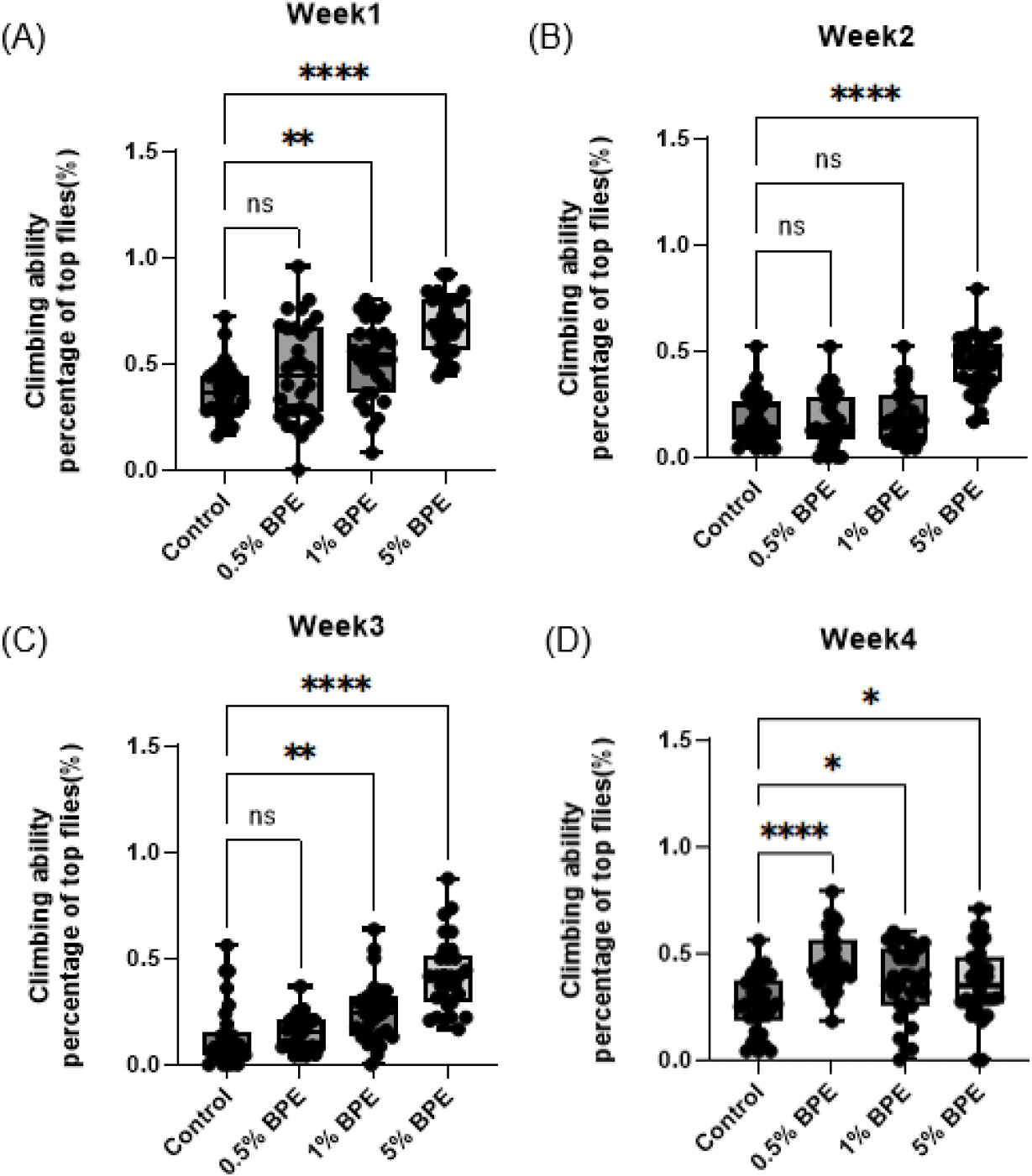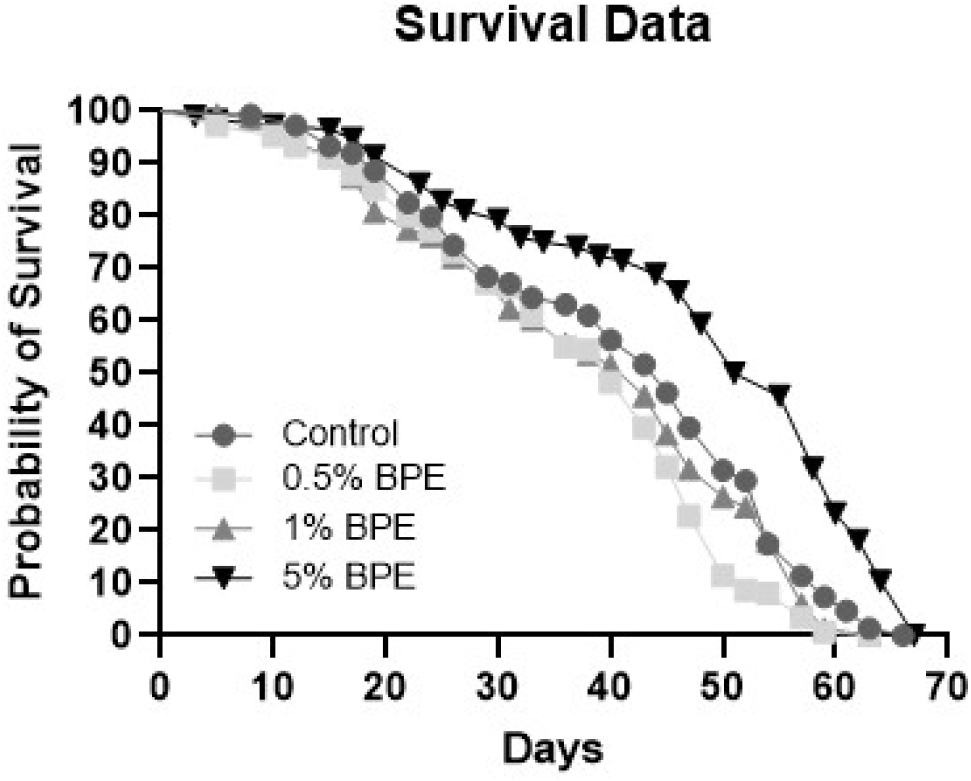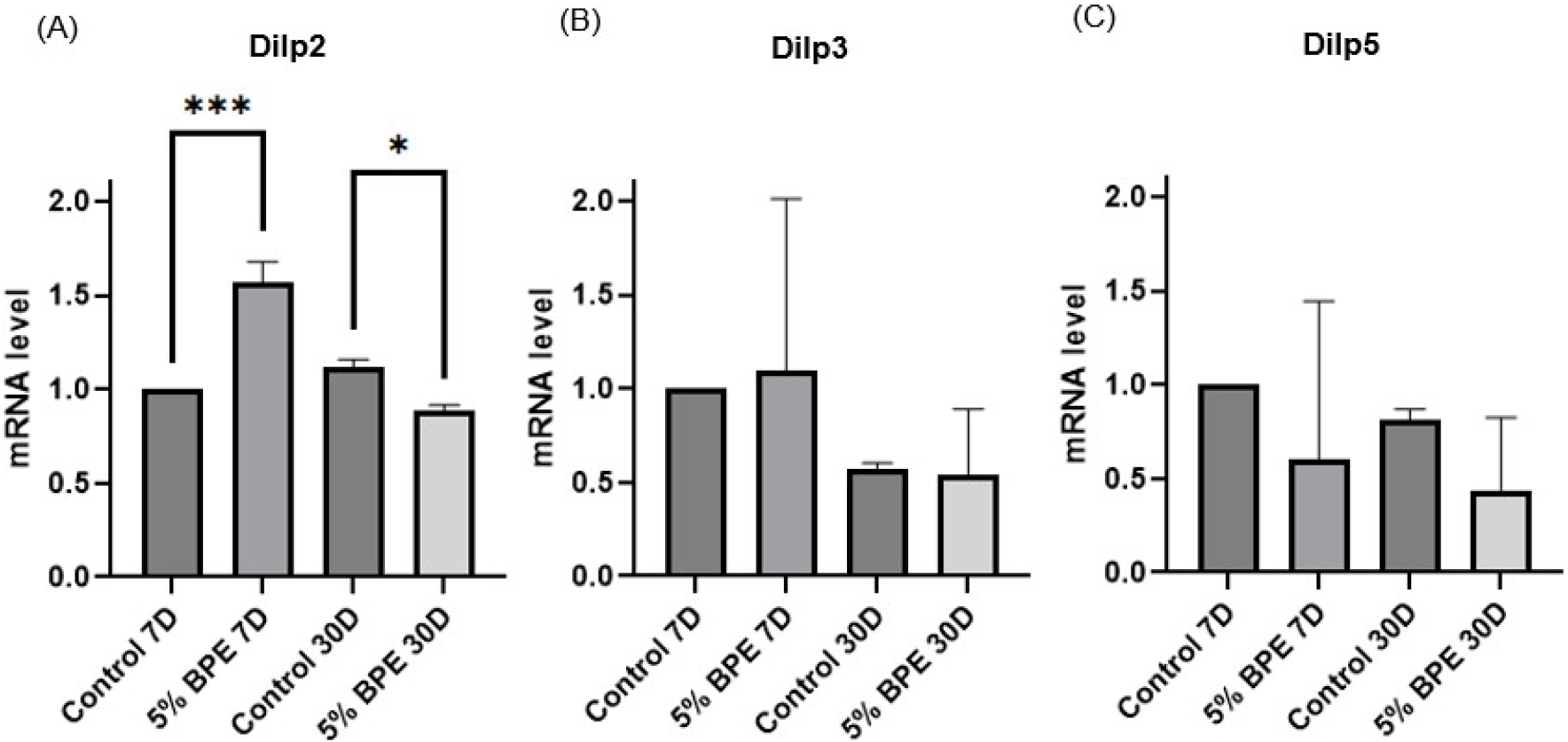INTRODUCTION
With growing environmental concerns, there is increasing interest in developing functional applications from food by-products. Banana peels, often discarded despite being nutrient-rich, represent a valuable resource for sustainable utilization and recycling efforts (Hikal et al., 2022; Priyanka et al., 2023). Bananas are known to contain melatonin, which has been shown to promote balanced sleep and reduce reactive oxygen species (ROS) in cells (Sundaram et al., 2011; Jenkins et al., 2016; Wang et al., 2022). Additionally, banana peels are rich in melatonin as well as amino acids such as leucine, valine, phenylalanine, and threonine, which contribute to their antioxidant and antimicrobial properties. Previous studies have demonstrated that banana peels support gastrointestinal health, alleviate constipation, induce sleep, exhibit anti-obesity effects, and facilitate the conversion of tryptophan to serotonin, thereby mitigating depression and mood disorders (Barroso et al., 2022; Mohd Zaini et al., 2022; Singh et al., 2023). However, their potential effects on aging have not yet been explored. Investigating new functional applications of banana peels related to aging could provide insights into both environmental sustainability and resource efficiency.
The aging process in D. melanogaster is complex and influenced by various genetic, cellular, and environmental factors. Several key pathways, including the insulin/insulin-like growth factor (IGF) signaling pathway, the mechanistic target of rapamycin (mTOR) pathway, the Sirtuin pathway, and dietary restriction, play pivotal roles in regulating aging in Drosophila (Kakanj et al., 2016). Among these, the Insulin/IGF signaling pathway is a primary regulator of aging and is highly conserved across species, including humans (Viola et al., 2023). A reduction in Insulin/IGF signaling has been shown to extend lifespan in Drosophila (Lamming, 2018). In this species, Drosophila insulin-like peptides (DILPs), particularly Dilp2, are critical components of insulin signaling. Dilp2 binds to the insulin receptor (InR) and is closely associated with lifespan regulation (Post et al., 2018). Lower levels of Dilp2 correlate with reduced insulin signaling and increased lifespan (Broughton et al., 2008). Additionally, Dilp2 influences the expression of Dilp3 and Dilp5, which similarly modulate insulin signaling and lifespan when their levels are reduced. Dietary restriction in humans, which is associated with reduced insulin levels, has been linked to lifespan extension, a phenomenon that has been well documented in previous studies.
This study aims to investigate the potential anti-aging effects of banana peel extracts (BPEs) using the Drosophila model system, with a focus on lifespan extension and improved locomotion. We demonstrate that BPEs-fed flies exhibit an extended lifespan, which is mediated through the insulin signaling pathway. Specifically, we observed a reduction in Dilp2 mRNA levels in aged flies administered with BPEs. Our findings suggest that BPEs may enhance locomotor function and extend lifespan in Drosophila by modulating insulin signaling. By examining the underlying mechanisms of lifespan extension in BPEs-fed flies, this study provides evidence that the insulin signaling pathway plays a crucial role, potentially offering new avenues for research on the anti-aging properties of banana peels in both Drosophila and other organisms.
MATERIALS AND METHODS
Banana peels were juiced using a fruit juicer. The extract was centrifuged, and the supernatant was collected. For short-term use, the extract was stored at 4°C, and for long-term use, it was stored at −20°C to prevent browning and degradation. The extract was mixed with Drosophila media at varying concentrations and stored at 4°C until use.
Empty vials were marked at 2.5 cm intervals (bottom, middle, top). Twenty-five flies were placed in empty column vials and gently tapped to the bottom of the column. After 10 s, flies that climbed above the 2-inch lines on the vial were counted. The rate of flies that passed the target line were recorded. The assay was repeated five times for each vial of flies at 5-minute intervals.
For longevity measurement, newly emerged w1118 flies (1–3 days old flies) were collected and divided into vials with 25 flies per vial (n=approximately 150). The media was changed every 2–3 days, and the number of dead flies was recorded to generate a survival curve.
Total RNA was extracted from 20 fly heads using Easy-BLUE (INtRON Biotechnology, Seongnam, Korea), followed by chloroform and isopropanol purification. The RNA was diluted in DEPC-treated water, and cDNA was synthesized by using High-Capacity cDNA Reverse Transcription Kit (Applied Biosystems, Waltham, MA, USA).
Quantitative PCR was performed by using Power SYBR™ Green PCR Master Mix (Applied Biosystems™). Each mRNA level was normalized by RP49 mRNA levels. Primers used were as follows: Dilp2 (F: GTATGGTGTGCGAGGAGTAT, R: TGAGTACACCCCCAAGATAG), Dilp3 (F: AAGCTCTGTGTGTATGGCTT, R: AGCACAATATCTCAGCACCT), and Dilp5 (F: AGTTCTCCTGTTCCTGATCC, R: CAGTGAGTTCATGTGGTGAG).
Data were obtained from at least three independent experiments and presented as means±SEM. All statistical analyses were performed using GraphPad Prism 9.5.1 software (GraphPad Software, San Diego, CA, USA). The results were statistically evaluated using the t-test. Differences were considered significant when p<0.05 and are indicated as follows: * p<0.05, ** p<0.01, *** p<0.001, **** p<0.0001. ns, not significant.
RESULTS
Banana peels are known for their diverse bioactive properties, including antioxidant, antibacterial, anti-obesity, and sleep-enhancing effects. However, their potential anti-aging effects, particularly in D. melanogaster, are not yet fully understood. Age-related decline in climbing ability is a well-documented phenomenon in Drosophila, serving as a reliable indicator of overall physical health and neuromuscular function. We hypothesized that BPEs might mitigate age-associated deterioration in physical activity. To test this, we conducted a climbing assay, a widely used method for assessing locomotor function in Drosophila (Martinez et al., 2007). Flies were fed with BPEs-supplemented media, and their climbing ability was monitored weekly. Our results indicated that 5% BPEs-treated flies exhibited a significant improvement in climbing ability during weeks 1 to 4 compared to the control group (Fig. 1). These findings suggest that BPEs can alleviate the decline in climbing performance associated with aging, potentially through their impact on muscle integrity, highlighting a novel functional property of banana peels.

Aging is a complex biological process characterized by progressive functional decline at the molecular and cellular levels, often resulting in an increased risk of diseases such as neurodegenerative disorders, metabolic conditions, and cardiovascular diseases (Guo et al., 2022). In Drosophila, climbing ability and muscle degeneration are closely linked to lifespan. Given the observed enhancement of climbing ability in BPEs-fed flies, we investigated whether these effects correlated with an extended lifespan. Consistent with our climbing assay results, 5% BPEs-treated flies demonstrated a significant increase in lifespan compared to the control group (Fig. 2). This suggests that BPEs may exert a protective effect against age-related muscle degeneration, thereby extending lifespan.

The Insulin/IGF-1 signaling pathway is a well-established regulator of aging and is influenced by both dietary intake and muscle function (Bai et al., 2013). In mammals, reduced insulin levels, mediated by decreased secretion from pancreatic beta cells, are associated with increased lifespan. We hypothesized that the lifespan-extending effects of BPEs in Drosophila might involve modulation of the insulin signaling pathway. To investigate this, we analyzed the expression levels of Dilp2, Dilp3, and Dilp5 mRNA using quantitative real-time PCR (qPCR). Our results showed a significant reduction in Dilp2 mRNA levels in aged, BPE-treated flies (30 days), which is associated with extended lifespan (Fig. 3). However, Dilp3 and Dilp5 mRNA levels are not significantly changed (Fig. 3). These findings suggest that BPE-induced lifespan extension in Drosophila is mediated, at least in part, through downregulation of insulin signaling. This study provides potential evidence that BPEs exert anti-aging effects via modulation of the insulin signaling pathway.

DISCUSSION
Banana peels are abundant in bioactive compounds such as antioxidants, polyphenols, and flavonoids, which are known to exert various biological effects (Toh et al., 2016; Rigopoulos et al., 2019). Notably, BPEs have demonstrated anti-inflammatory properties through the suppression of NF-κB activation, leading to decreased levels of pro-inflammatory cytokines, including IL-1α and TNF-α (Savitri et al., 2023). It is well-established that the upregulation of ROS and nitric oxide (NO) can trigger inflammatory responses (Seif et al., 2019; Oboh et al., 2020). The anti-inflammatory effects of BPEs may be attributed to their ability to reduce the production of ROS and NO, thus mitigating inflammation. While numerous studies have explored the potential biological activities of BPEs across various model systems, their effects on aging remain underexplored.
In this study, we investigated the anti-aging potential of BPEs in D. melanogaster. Our findings demonstrated that BPEs treatment improved climbing ability in aged flies and significantly extended their lifespan. Additionally, BPEs-fed flies exhibited reduced mRNA expression levels of Dilp2, a gene encoding Dilp2. The insulin and IGF factor signaling (IIS) pathway is a key regulator of numerous cellular processes, including metabolism, stress resistance, and longevity across multiple species (Barbieri et al., 2003). In Drosophila, Dilps—homologs of mammalian insulin and IGF—are critical regulators of the IIS pathway. Among the eight known Dilps (Dilp1-8), Dilp2, Dilp3, and Dilp5 are predominantly expressed in the insulin-producing cells of the brain in adult flies and can bind to the InR, thereby activating the IIS pathway (Broughton et al., 2005; Nässel et al., 2015).
Dilp2 is one of the most extensively studied genes in the context of aging and lifespan regulation. Several studies have shown that reduced levels of Dilp2, whether due to genetic mutation or specific interventions, are often associated with increased lifespan (Grönke et al., 2010; Kannan & Fridell, 2013; Yoon et al., 2024). Our results also confirmed that long-lived Drosophila exhibited reduced Dilp2 mRNA expression. A decrease in Dilp2 levels attenuates IIS pathway activity, leading to the activation of the transcription factor FOXO, which subsequently induces the expression of genes associated with stress resistance and longevity (Altintas et al., 2016).
Aging in Drosophila is accompanied by a decline in muscle function, which serves as a model for studying muscle degeneration and age-related diseases. In aged flies, various cellular mechanisms deteriorate, resulting in decreased muscle strength, reduced climbing ability, and increased susceptibility to age-related disorders (Demontis & Perrimon, 2010; Demontis et al., 2013). Improvement in locomotor ability, such as enhanced climbing performance, can thus be a direct indicator of improved muscle function and overall health in aging studies (Arabit et al., 2018).
Our findings suggest that BPEs hold potential as a novel anti-aging intervention, capable of improving both lifespan and physical health in Drosophila by modulating the IIS pathway. This study highlights the value of banana peels, a commonly discarded food by-product, as a functional ingredient with potential applications in health and longevity research. Future studies should aim to elucidate the specific bioactive components responsible for these effects and explore their potential applicability in other model organisms. In summary, this study provides evidence that BPEs could serve as a promising candidate for the development of functional applications using food by-products, a field that is gaining increasing attention due to its implications for sustainability and health.

